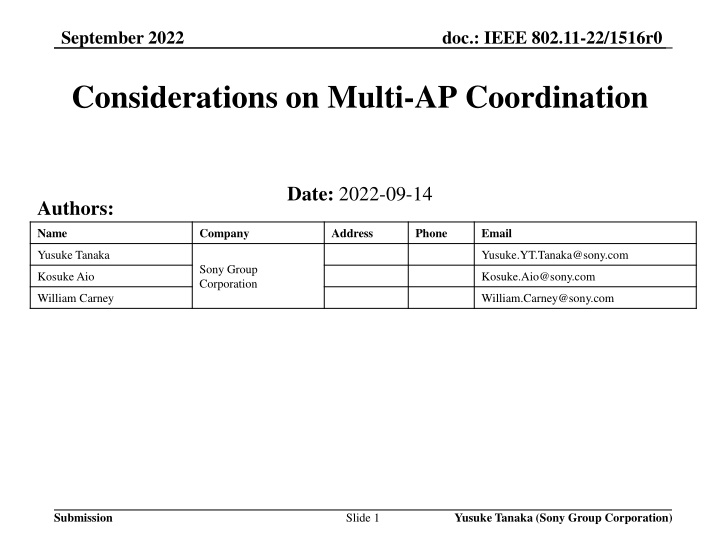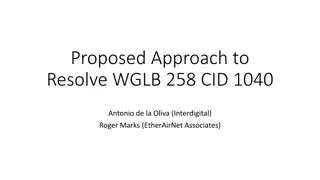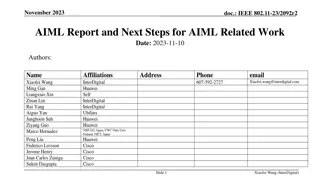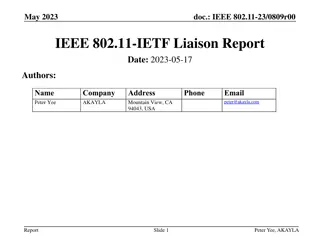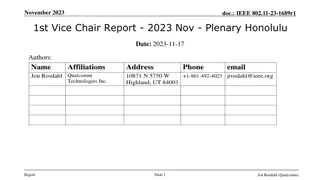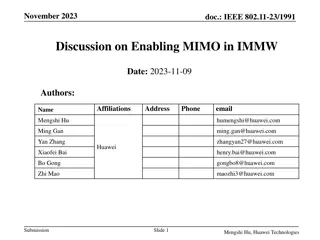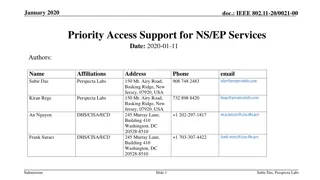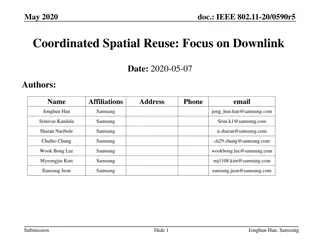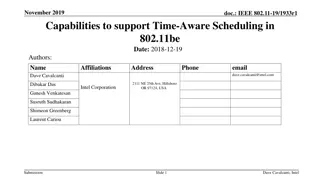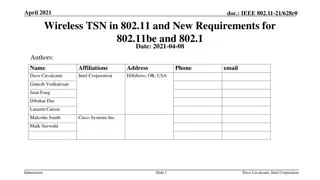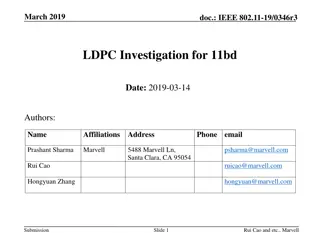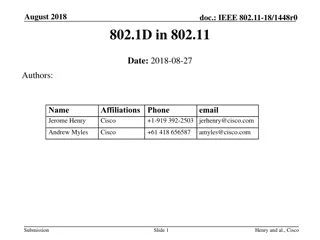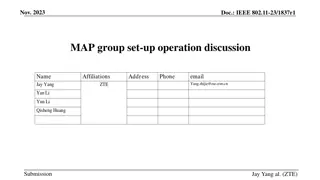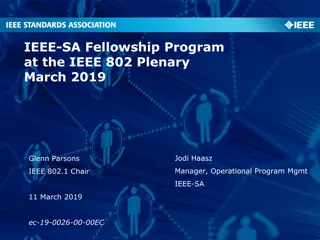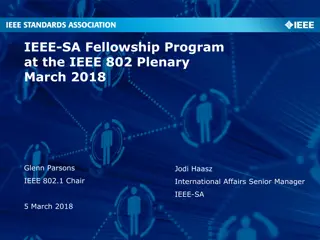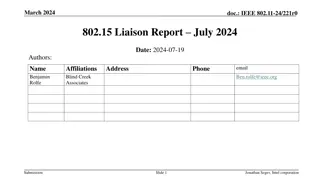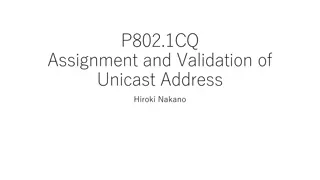IEEE 802.11-22/1516r0 AP Coordination Considerations
Review of discussions on AP coordination in WNG sessions and EHT SG/TGbe meetings, proposing advancements for future WLAN technology. Emphasis on the importance of prioritizing AP coordination to address various WLAN objectives effectively. Details on AP coordination subtypes and their impact on reliability, latency, manageability, throughput, and power consumption.
Download Presentation

Please find below an Image/Link to download the presentation.
The content on the website is provided AS IS for your information and personal use only. It may not be sold, licensed, or shared on other websites without obtaining consent from the author.If you encounter any issues during the download, it is possible that the publisher has removed the file from their server.
You are allowed to download the files provided on this website for personal or commercial use, subject to the condition that they are used lawfully. All files are the property of their respective owners.
The content on the website is provided AS IS for your information and personal use only. It may not be sold, licensed, or shared on other websites without obtaining consent from the author.
E N D
Presentation Transcript
September 2022 doc.: IEEE 802.11-22/1516r0 Considerations on Multi-AP Coordination Date: 2022-09-14 Authors: Name Company Address Phone Email Yusuke Tanaka Yusuke.YT.Tanaka@sony.com Sony Group Corporation Kosuke Aio Kosuke.Aio@sony.com William Carney William.Carney@sony.com Submission Yusuke Tanaka (Sony Group Corporation) Slide 1
September 2022 doc.: IEEE 802.11-22/1516r0 Introduction Multiple AP environment and AP coordination technology were discussed in the recent WNG sessions and previously EHT SG/TGbe as worthwhile topics for the next generation WLAN. This contribution reviews discussions related to AP coordination during the WNG sessions and EHT SG/TGbe. Based on the observation, this contribution proposes some way forwards for the future discussion. Submission Yusuke Tanaka (Sony Group Corporation) Slide 2
September 2022 doc.: IEEE 802.11-22/1516r0 Review of WNG discussion (1/2) Various envisioned use cases were proposed during WNG, and diverse requirements to realize them were shown. In consideration of those proposals, the motion to form UHR SG with the following multiple objectives was approved. Improve reliability of WLAN connectivity Reduce latencies Increase manageability Increase throughput at different SNR levels Reduce device level power consumption To meet these objectives, it is effective to give priority to features that are able to address several objectives with one feature. It is possible to reduce the amount of amendment and standardization work, and to allocate standardization resources to other complementary features. Submission Yusuke Tanaka (Sony Group Corporation) Slide 3
September 2022 doc.: IEEE 802.11-22/1516r0 Review of WNG discussion (2/2) AP coordination are able to address the several objectives by its coordination subtypes. 1. Coordinated OFDMA: Multiple APs coordinate RUs and perform OFDMA. 2. Coordinated Spatial Reuse: Multiple APs coordinate or instruct transmission parameters (e.g., transmission power) and perform spatial reuse. 3. Coordinated Beamforming: Multiple APs form beam/null so as not to interfere with each BSSs. 4. Joint Transmission: Multiple APs transmit to the same single or multiple STAs simultaneously as if these are a single AP. All subtypes enable parallel transmission without waiting and achieve low latency. All subtypes enable collision avoidance between APs and achieve high reliability. All subtypes are able to improve throughput. Principles differs for each subtype (better spectrum utilization, interference reduction etc.), and the amount of improvement is generally large in the order of 4. (largest) > 3. > 2. > 1. > no coordination. Submission Yusuke Tanaka (Sony Group Corporation) Slide 4
September 2022 doc.: IEEE 802.11-22/1516r0 Observation and way forwards Many contributions[1-6] also expect that AP coordination is a mean to achieve the objectives and realize the use cases. Considering these points, AP coordination is a potential feature and should be prioritized in UHR discussion. Proposed way forwards based on the review of WNG discussion: AP Coordination should be prioritized in UHR SG, and discussion about coordination subtypes, network structure, and performance evaluation should be proceeded. Multi-AP environment and/or AP coordination should be captured in the PAR to be constructed, but it is a future discussion. Submission Yusuke Tanaka (Sony Group Corporation) Slide 5
September 2022 doc.: IEEE 802.11-22/1516r0 Review of EHT SG/TGbe discussion (1/3) The following items had been profoundly discussed, and the useful fruits are provided as contributions and are available for reuse. Terminology [7], [8] Coordinated techniques and Joint techniques Sharing AP & Shared AP Coordination type [7], [9] Joint processing (transmission/reception) Coordinated OFDMA, Coordinated Spatial Reuse Coordinated Beamforming, Coordinated Nulling Scenario [10] Home Mesh AP Scenario and detailed parameters Submission Yusuke Tanaka (Sony Group Corporation) Slide 6
September 2022 doc.: IEEE 802.11-22/1516r0 Review of EHT SG/TGbe discussion (2/3) Spec Framework Document [11] The TGbe SFD included a subclause about Multi-AP, 9. Multi-AP operation, based on a bunch of approved motions. Below is a summary of what each subclause contains. 9.1 General 9.2 Setup Definition of sharing AP and shared AP Primary 20MHz setting in sharing AP and shared AP 9.3 Channel sounding Joint NDP sounding scheme Sequential 11ax-like sounding sequence to collect CSI from in-BSS/OBSS STAs NDPA frame and BFRP Trigger frame design (OBSS STA s ID) and behavior of STA received the frames from OBSS AP Submission Yusuke Tanaka (Sony Group Corporation) Slide 7
September 2022 doc.: IEEE 802.11-22/1516r0 Review of EHT SG/TGbe discussion (3/3) 9.4 Coordinated transmission AP candidate set (APs that can initiate or participate in multi-AP coordination) A procedure for an AP to share its frequency/time resources Optional feedback from APs from the AP candidate set to learn the resource needs Coordinated OFDMA Coordinated UL MU-MIMO 9.5 Other Multi-AP coordination schemes Coordinated spatial reuse Joint transmission for single- and multi-user Coordinated BF Submission Yusuke Tanaka (Sony Group Corporation) Slide 8
September 2022 doc.: IEEE 802.11-22/1516r0 Observation and way forwards The SFD well covers basic definitions and procedures, as well as descriptions of support of high-level coordination subtypes. Proposed Way Forwards based on review of EHT SG/TGbe discussion Related agreements for Multi-AP and previously approved as motions in the TGbe SFD, should carry over to UHR to allow faster progress on completing the PAR and spec development. Minor changes like subclause structure or Notes could be considered. Modification based on changes since then (e.g. Multi-Link feature) should be reexamined. Submission Yusuke Tanaka (Sony Group Corporation) Slide 9
September 2022 doc.: IEEE 802.11-22/1516r0 Summary This contribution reviewed the discussions about AP coordination during the WNG sessions and EHT SG/TGbe. This contribution offered following way forwards based on the observation from the review. 1. AP Coordination should be prioritized in UHR SG, and discussion about coordination subtypes, network structure, and performance evaluation should be proceeded. 2. Related agreements for Multi-AP and previously approved as motions in the TGbe SFD, should carry over to UHR to allow faster progress on completing the PAR and spec development. Submission Yusuke Tanaka (Sony Group Corporation) Slide 10
September 2022 doc.: IEEE 802.11-22/1516r0 Reference [1] 22/734 Next Gen After 11be: Main Directions Proposal [2] 22/729 802.11 GEN8 Study Group [3] 22/932 Thoughts on Beyond 802.11be [4] 22/965 View on Beyond BE [5] 22/694 Thoughts on Next Gen WLAN [6] 22/697 Next-generation WLAN technology inspired by XR [7] 18/1926 Terminology for AP Coordination [8] 19/1895 Setup for Multi-AP coordination [9] 18/1509 Discussions on Multi-AP Coordination [10] 20/0032 Consideration on Multi-AP Home Mesh AP Scenario [11] 19/1262 Specification framework for TGbe Submission Yusuke Tanaka (Sony Group Corporation) Slide 11
